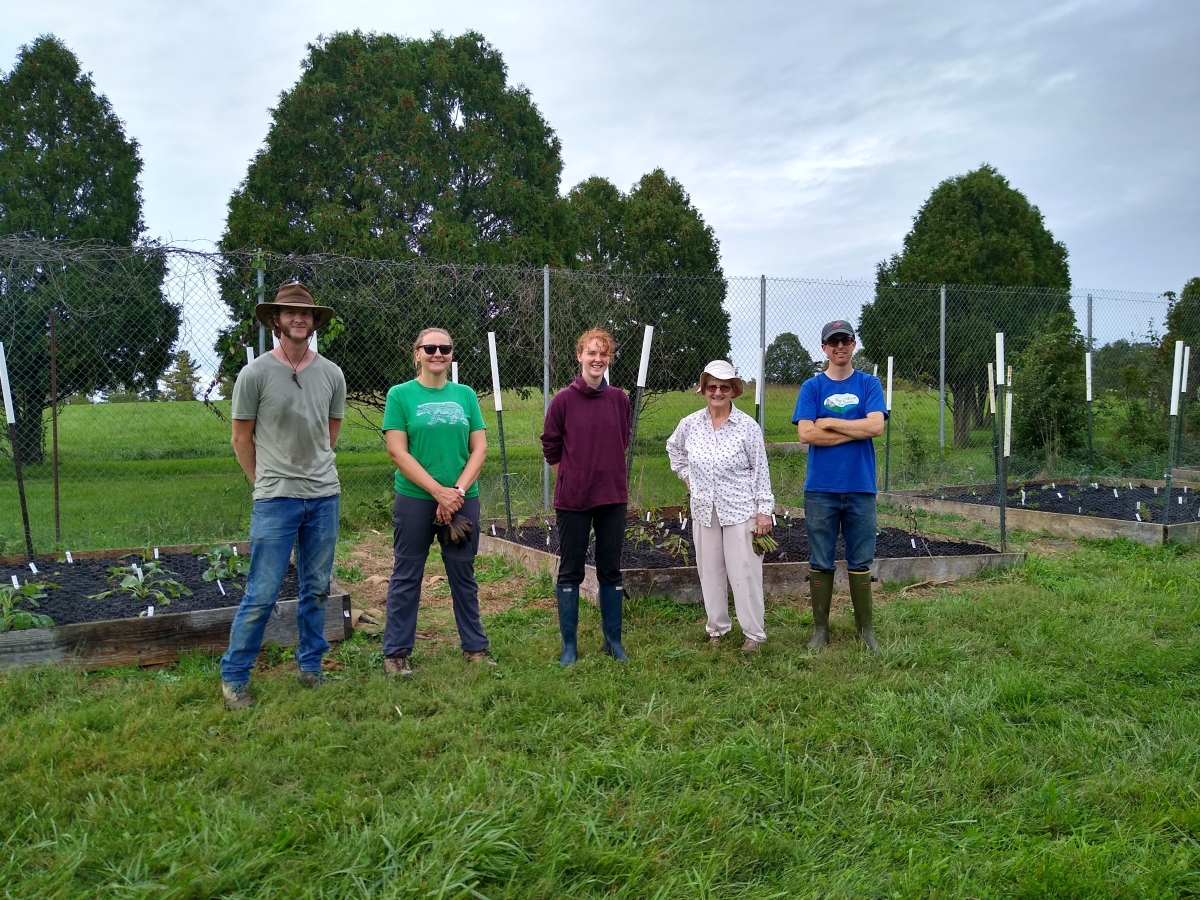
Have a Joyous, Family- and Friends-Filled Thanksgiving!
As always, we're so very thankful for you!
At this time of year, after many months of disrupted plans and missed gatherings for all of us, we want to say a very heartfelt “Thank you!” for your continued support of Blandy Experimental Farm and the State Arboretum of Virginia. Your love of nature and caring for our mission of environmental research and education ensure we all continue to grow and prosper in this often crazy and unpredictable world. We’re very grateful for you!

Blandy Partners with the Clifton Institute for Local Plant Conservation
by Jack Monsted, Assistant Curator, Native Plant Trail
"The goal of these plantings is to produce enough seed to distribute to interested local landowners through sales and seed swaps."
When most people think of endangered species conservation, a few well-publicized species spring to mind: giant pandas, tigers, African lions, polar bears, and spotted owls. These large, charismatic animals on the brink of extinction are easy to recognize, easier to love, and receive the lion’s share (no pun intended) of the attention and funding for conservation. But one endangered species that almost no one knows about is Torrey’s mountain mint. Even as a botanist, I’ll admit that the first time I heard about this plant my reaction was mostly confusion: Who is this Torrey person, and will their mint be tasty in a mojito?
And yet, this elegant little plant with narrow leaves, a square stem, and small clusters of purplish-white flowers is in trouble. Native to Virginia and surrounding states, the once relatively common plant now has fewer than 20 known wild populations throughout the world and is listed as a globally ‘imperiled’ species under Nature Serve’s species conservation ranking system, a more severe conservation ranking than even the polar bear’s “vulnerable.”
Knowing this, a straightforward question presents itself to conservation-oriented institutions like Blandy Experimental Farm and the Clifton Institute: How do we save Torrey’s mountain mint and other plants like it? The open, wild grassland ecosystems in which the plant thrives are disappearing throughout the Eastern US, replaced by farms and an ever-expanding patchwork of housing developments. Simply setting aside large preservations of land where the plant still exists might not do the trick either – rare plants with small populations can rapidly disappear if invasive plants are introduced into their habitat or extreme weather events occur too frequently.
Some potentially suitable landscape types that are not diminishing, however, are human engineered ones – gardens, meadows, and woodlands intentionally grown on private property. Many people are starting to recognize the aesthetic and environmental value of native plants in landscaping – and in doing so becoming backyard conservationists themselves. The only trouble here is one of availability – where do conservation-minded landowners acquire these unique plants that are hard to find but would benefit the most from increased planting?
Most native seed suppliers carry only the most common and showy native wildflowers, which is just a small subsection of our incredibly diverse flora. Furthermore, most commercially available plants are sourced from only a few areas and shipped to other parts of the country – a framework that doesn’t preserve local varieties of plants and often produces an inferior product for customers (a milkweed adapted to Minnesota weather might not do well in the warmer climates of Virginia).
This is where Blandy and the Clifton Institute come in. One of the State Arboretum’s core missions is to preserve biodiversity, but opportunities to extend that mission beyond our property lines are few and far between. So when the Clifton Institute asked if we’d like to start a plot to produce seeds of rare and locally unavailable plants like Torrey’s mountain mint, we jumped at the opportunity. For the past few years, the Clifton Institute has been growing seedlings of many fascinating native plants that can’t be purchased locally, and this October we filled several research beds with many of them, including stiff goldenrod (Solidago rigida), upland ironweed (Vernonia glauca), pasture thistle (Cirsium pumilum), late blue aster (Symphyotrichum patens), and of course Torrey’s mountain mint (Pycnanthemum torreyi). Our Native Plant Trail volunteer crew was essential in preparing and planting the beds and will continue to look after them as they mature and start to flower.
The goal of these plantings is to produce enough seed to distribute to interested local landowners through sales and seed swaps. The plants will need at least a year or two before any significant amount of seed is produced, but stay tuned: Maybe you’ll be able to add the beautiful white flowers of Torrey’s mountain mint to your garden – and help save an endangered species in the process.

The Arboretum Pushes Back Against Spotted Lanternfly
by T'ai Roulston, Curator of the State Arboretum of Virginia
"It's like trying to kill a vampire: Weaken him with sunlight, holy artifacts, and garlic, then stab him a few hundred times and see what happens."
Last year, we found the first spotted lanternflies at Blandy. We squished, squashed, and scraped both bugs and eggs then worked to reduce their favorite host, the tree of heaven, Ailanthus altissima. This is no easy task, as it is one of the most common weed trees in our area. It thrives in vacant lots, roadsides, fields, and light gaps in forests; it finds the corner of your yard that goes uncut and takes over, and when you cut it down, it sprouts a forest of itself. You have to cut and poison it to kill it, or cut it for years, or dig until your blisters have blisters. It's like trying to kill a vampire: Weaken him with sunlight, holy artifacts, and garlic, then stab him a few hundred times and see what happens.
So this has been the year of trying to kill Ailanthus. We started with 129 trees planted 9 years ago for research. We cut them all and herbicided the trunks. Then we turned to the wild trees in the area on the eastern border, where we'd found our first lanternflies. Dozens more cut down or girdled and treated. Next came old arboretum specimens. Six stood on Pea Hill, planted in the 1930s as specimen trees before their invasiveness was known. At sunup in April they were large trees silhouetting the sky; at sundown they were sawdust and logs. Then back to more wild areas, girdling the trunks and herbiciding the cuts, trying to cut off the food supply. And yet the lanternflies gather below the cut trunk or girdled bark and feed where they can. We find egg cases low on the underside of a bent trunk, or high where we can't reach, or on the surface of a smooth rock, or the top of a water tank. The new egg cases, pinkish gray and soft as fresh putty, are easily burst with a blunt stick, but as soon as we scrape them clean, new ones form above us, below us, in the next tree, or on a rock around the corner. Its host tree may be Dracula, but the lanternflies themselves are Tolkienian orcs; for each one slain, a hundred more rise from the foul earth to take its place.
So we are not winning this battle, but hopefully, over time, we'll deprive them of the bulk of their preferred host plants and then some parasites will become well established and feed on their abundant and juicy bodies. The lanternflies may seem fast to us, but to the right parasite, they will be slow food, every day Thanksgiving. I doubt we will ever get rid of them entirely, but maybe we can drop them below plague status and keep the native host plants, arboretum specimens, and susceptible crop plants in good shape.
Why are we concerned about spotted lanternflies?
It is a newly arrived invasive pest that prefers and likely needs weedy Ailanthus trees for part of its life cycle but feeds heavily on many other trees, shrubs, and vines, like red maple, silver maple, black walnut, rose bush, and grape vines, which can damage the trunks and substantially reduce the harvest of some crops, especially grapes. They also pass a sticky substance called 'honeydew' through their bodies while feeding. The honeydew coats the trunks, ground, road, and cars in a clear sticky substance that then attracts bees, wasps, and ants. For information about quarantines in effect in our area, see: https://www.vdacs.virginia.gov/press-releases-210209-spotted-lanternfly.shtml. For general information about the pest and the invasion, see the USDA-APHIS website: https://www.aphis.usda.gov/aphis/resources/pests-diseases/hungry-pests/the-threat/spotted-lanternfly/spotted-lanternfly.
